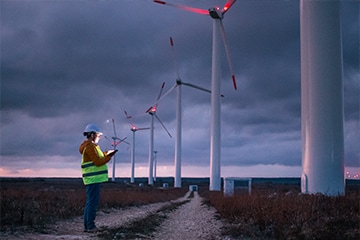Deloitte AI Institute
The Energy, Resources & Industrials AI Dossier
Top uses for AI in the energy, resources, and industrials industry — now and in the future
Examine AI and machine learning in the energy, resources and industrials industry
AI adoption and deployment seem to be less extensive and mature in Energy, Resources & Industrials (ER&I) than in most other industries.
So far, there have been fewer big AI success stories in ER&I — and thus less competitive pressure to take immediate action. Although most ER&I companies generally acknowledge the importance of AI — and see it is an essential and disruptive capability that could greatly affect their ability to operate and compete in the future — most efforts to date have been limited to small-scale pilots and proofs-of-concept focused on narrow parts of the business.

ER&I-related companies have the most to gain — and lose — from the latest surge of AI into the marketplace. AI has become more affordable, achievable, and most of all, its benefits are increasingly accepted by the marketplace. AI is also becoming a business imperative. In short, the time is now for ER&I to embrace the AI revolution.
of ERI organizations classify AI as “highly important” to the manufacturing function in the next five years.
of oil and gas execs say the benefits of digitization outweigh the cybersecurity risk
Facing the top obstacles
Most ER&I-related companies are increasingly deploying artificial intelligence, yet many are still facing challenges in their AI initiatives:
- Digital data vs. physical work and assets: Unlike many other industries where digital data plays a central role, ER&I still revolves around physical work and physical assets — with many of those assets geographically scattered and disconnected from digital networks. Widespread deployment of IoT-related technologies is starting to fill this data void. However, in order to be useful, the resulting data needs to be organized, captured, and analyzed in a timely manner. Also, edge computing and edge AI technologies should be harnessed to enable timely processing and analysis of data in dispersed locations at the edge of the network.
- Lack of internal AI-expertise: Developing a pool of resources with expertise in AI, data science, and data engineering to serve as a focal point for all AI-related activities and investments is a necessity. This team would coordinate AI activities across the company’s business ecosystem, while providing a core set of internal AI resources and capabilities that can be supplemented from the outside as needed. Also, the team would provide a broad, balanced, and informed perspective on using AI across the enterprise.
- Overly tactical and technical AI initiatives: Too many AI initiatives and visions in ER&I are either overly tactical and technical (too narrowly focused, and often highlighting technical capabilities that are exciting but not very useful), or overly strategic and ambitious (too difficult and expensive to implement, requiring data and advanced capabilities that don’t currently exist). To succeed with AI, ER&I companies should have strategies and roadmaps based on a practical understanding of what parts of the business are best suited for AI.
Where are the opportunities for ER&I companies?
AI has the potential to cut energy waste, lower energy costs, and facilitate and accelerate the use of clean renewable energy sources in power grids worldwide. It can also improve the planning, operation, and control of power systems and can be used to improve interactions with customers and field workers.
Some ER&I companies are starting to explore the use of AI to help them handle extreme weather and other hard-to-predict events. By harnessing the power of AI vision and other advanced AI technologies, companies can monitor and analyze vast amounts of information — including data from field sensors, drone video, and weather radar — with a level of timeliness, accuracy, and thoroughness that humans alone simply cannot achieve.
Expanding on the idea of machines helping humans be more efficient and effective, AI’s single biggest impact in ER&I could be helping companies address the future workforce gap. The Biden administration’s multi-trillion dollar commitment to infrastructure is expected to dramatically increase business activity throughout ER&I, but could also create a significant shortage of workers and expertise. AI can help address this gap by augmenting the work done by humans — doing much of the preparatory analysis and heavy lifting so human workers can focus on activities that require skills and expertise that are uniquely human.
of oil and gas companies plan to increase investments in analytics, AI/machine learning (ML), automation, IoT, and cloud this year.
Understanding what can be achieved by AI today
From increased efficiency and profits to improved decision-making, explore the way that ER&I businesses are harnessing the power of AI in our five use cases:
Keeping downtime down
Predictive Machine Maintenance
Use AI to optimize industrial machine performance, predict failures, and inform maintenance requirements with IoT - powered asset monitoring.
AI at the edge
Edge AI for Production and Planning
Use IoT solutions based on Edge AI to streamline production and planning processes — and reduce unexpected downtime.
Making sense of sensor data
Field Sensor Data Analysis
Use AI technologies to analyze real-time data from networks of sensors in the field (combined with scientific knowledge models and information about various environmental/peripheral factors such as seismic activity, drilling logs, cores, completion designs, production data, and maintenance records).
Fielding questions from the field
Field Workforce Support and Safety
Use AI technologies such as natural language processing (NLP) to give field workers easy access to critical information. Also, use computer vision and machine learning algorithms to sense dangerous working conditions and automatically generate alerts.
Keeping the lights on
Predictive Insights for Utility Service Outages
Use AI algorithms and predictive analytics to forecast energy loads and peaks in demand — reducing service outages, and providing customers with more accurate timing and duration estimates for outages that cannot be avoided.
Navigating the future of AI in the ER&I industry
From automation to augmentation and beyond, AI is already starting to change the ER&I industry. The industry has made strides in digitizing operations over the years and is using AI to get the most out of data.
Explore our four emerging AI use cases in the ER&I industry to uncover future-driven opportunities:












